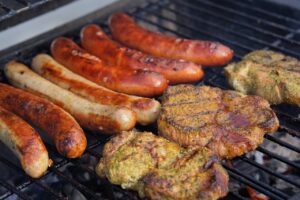Key Takeaway:
Below is a comprehensive griddle temperature chart, providing you with a quick reference for various cooking temperatures. Use this chart to ensure your food is cooked to perfection every time:
| Food Type | Temperature Range (Fahrenheit) |
|---|---|
| Bacon | 325-350 |
| Pancakes/Waffles | 375-400 |
| Burgers/Steaks | 400-450 |
| Chicken/Seafood | 350-375 |
| Vegetables | 300-350 |
| Eggs | 300-325 |
| Grilled Cheese Sandwiches | 325-350 |
Introduction
Cooking on a griddle can be a delightful experience, allowing you to create mouthwatering dishes with ease. However, ensuring the right cooking temperature can sometimes be a challenge.
Fear not! This article will provide you with a handy griddle temperature chart and offer useful tips to help you achieve culinary perfection.
The Griddle Temperature Chart
Using the right cooking temperature is crucial to achieve the desired texture and flavor of your dishes. Refer to the table below for specific temperature ranges for different types of food:
| Food Type | Temperature Range (Fahrenheit) |
|---|---|
| Bacon | 325-350 |
| Pancakes/Waffles | 375-400 |
| Burgers/Steaks | 400-450 |
| Chicken/Seafood | 350-375 |
| Vegetables | 300-350 |
| Eggs | 300-325 |
| Grilled Cheese Sandwiches | 325-350 |
Why is Temperature Important?
Maintaining the correct griddle temperature is vital to achieve the best possible cooking results. Here’s why:
- Even Cooking: Each type of food has a specific temperature range that allows it to cook evenly. By following the griddle temperature chart, you can avoid overcooking or undercooking your favorite dishes.
- Flavor Development: The right temperature helps to sear and caramelize food, enhancing its flavor and creating a delicious golden crust.
- Safety: Cooking food at the correct temperature helps to kill harmful bacteria, ensuring your meals are safe to eat.
Tips for Perfect Cooking Temps
Achieving the perfect cooking temperature on your griddle is an art. Here are some useful tips to help you do just that:
- Preheat Your Griddle: Before you start cooking, preheating your griddle is essential. This allows the surface to reach the desired temperature and ensures even heat distribution.
- Use a Thermostat: Investing in a griddle with a built-in thermostat can be a game-changer. It allows you to monitor and control the temperature accurately, resulting in consistently delicious meals.
- Oil Temperature: When cooking, be mindful of the oil temperature. Different oils have different smoke points, so choose the appropriate oil for each dish. The griddle temperature chart can guide you in making the right choices.
- Testing Temperature: Occasionally, when unsure if the griddle is at the correct temperature, perform a quick temperature test. Drop a few droplets of water on the surface – if they sizzle and evaporate quickly, it’s ready for cooking.
Examples of Temperatures in Action
Let’s take a closer look at how different griddle temperatures affect various dishes:
Example 1: Steak
For a perfectly juicy and seared steak, aim for a griddle temperature of 400-450°F. Sear both sides of the steak for a few minutes, then adjust the heat to finish cooking it to your desired level of doneness.
Example 2: Pancakes
To create fluffy and golden pancakes, set your griddle temperature between 375-400°F. Allow the pancake batter to spread evenly on the griddle, flip when bubbles appear, and cook until both sides are golden brown.
Example 3: Bacon
Crispy bacon lovers, rejoice! To achieve crispy perfection, heat your griddle to 325-350°F. Cook the bacon until it reaches your desired level of crispiness, flipping it occasionally for even cooking.
Conclusion
Cooking on a griddle becomes a breeze when you have the right temperature settings. Remember to refer to the griddle temperature chart provided in this article as a helpful reference.
Consider investing in a griddle with a built-in thermostat to ensure precise temperature control. With the right temperature and these tips in mind, your culinary creations are on their way to burst with flavor and perplex with delight!
